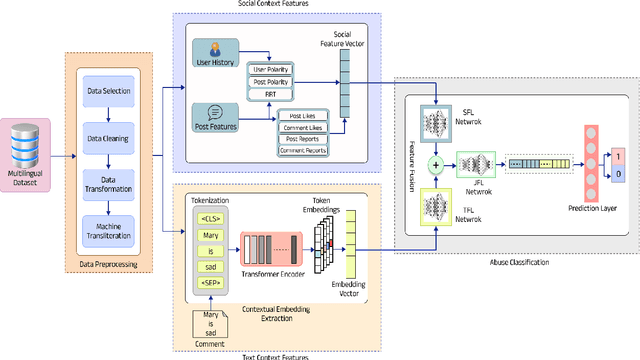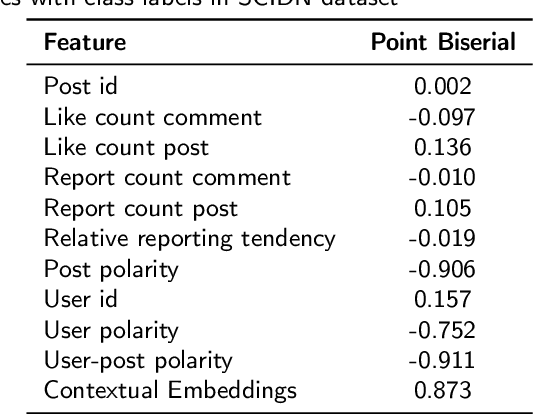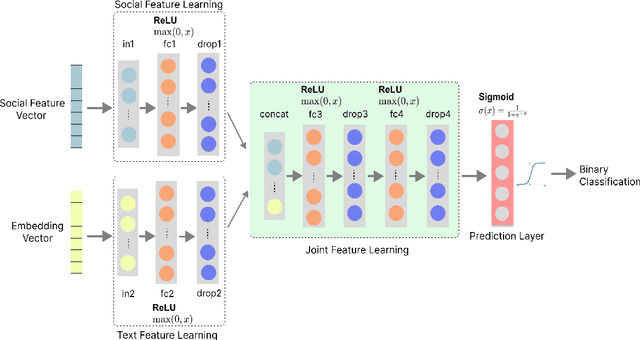Nagendra Kumar
A multi-temporal multi-spectral attention-augmented deep convolution neural network with contrastive learning for crop yield prediction
Sep 19, 2025Abstract:Precise yield prediction is essential for agricultural sustainability and food security. However, climate change complicates accurate yield prediction by affecting major factors such as weather conditions, soil fertility, and farm management systems. Advances in technology have played an essential role in overcoming these challenges by leveraging satellite monitoring and data analysis for precise yield estimation. Current methods rely on spatio-temporal data for predicting crop yield, but they often struggle with multi-spectral data, which is crucial for evaluating crop health and growth patterns. To resolve this challenge, we propose a novel Multi-Temporal Multi-Spectral Yield Prediction Network, MTMS-YieldNet, that integrates spectral data with spatio-temporal information to effectively capture the correlations and dependencies between them. While existing methods that rely on pre-trained models trained on general visual data, MTMS-YieldNet utilizes contrastive learning for feature discrimination during pre-training, focusing on capturing spatial-spectral patterns and spatio-temporal dependencies from remote sensing data. Both quantitative and qualitative assessments highlight the excellence of the proposed MTMS-YieldNet over seven existing state-of-the-art methods. MTMS-YieldNet achieves MAPE scores of 0.336 on Sentinel-1, 0.353 on Landsat-8, and an outstanding 0.331 on Sentinel-2, demonstrating effective yield prediction performance across diverse climatic and seasonal conditions. The outstanding performance of MTMS-YieldNet improves yield predictions and provides valuable insights that can assist farmers in making better decisions, potentially improving crop yields.
Two Stage Context Learning with Large Language Models for Multimodal Stance Detection on Climate Change
Sep 09, 2025Abstract:With the rapid proliferation of information across digital platforms, stance detection has emerged as a pivotal challenge in social media analysis. While most of the existing approaches focus solely on textual data, real-world social media content increasingly combines text with visual elements creating a need for advanced multimodal methods. To address this gap, we propose a multimodal stance detection framework that integrates textual and visual information through a hierarchical fusion approach. Our method first employs a Large Language Model to retrieve stance-relevant summaries from source text, while a domain-aware image caption generator interprets visual content in the context of the target topic. These modalities are then jointly modeled along with the reply text, through a specialized transformer module that captures interactions between the texts and images. The proposed modality fusion framework integrates diverse modalities to facilitate robust stance classification. We evaluate our approach on the MultiClimate dataset, a benchmark for climate change-related stance detection containing aligned video frames and transcripts. We achieve accuracy of 76.2%, precision of 76.3%, recall of 76.2% and F1-score of 76.2%, respectively, outperforming existing state-of-the-art approaches.
Emotion-aware Dual Cross-Attentive Neural Network with Label Fusion for Stance Detection in Misinformative Social Media Content
May 27, 2025Abstract:The rapid evolution of social media has generated an overwhelming volume of user-generated content, conveying implicit opinions and contributing to the spread of misinformation. The method aims to enhance the detection of stance where misinformation can polarize user opinions. Stance detection has emerged as a crucial approach to effectively analyze underlying biases in shared information and combating misinformation. This paper proposes a novel method for \textbf{S}tance \textbf{P}rediction through a \textbf{L}abel-fused dual cross-\textbf{A}ttentive \textbf{E}motion-aware neural \textbf{Net}work (SPLAENet) in misinformative social media user-generated content. The proposed method employs a dual cross-attention mechanism and a hierarchical attention network to capture inter and intra-relationships by focusing on the relevant parts of source text in the context of reply text and vice versa. We incorporate emotions to effectively distinguish between different stance categories by leveraging the emotional alignment or divergence between the texts. We also employ label fusion that uses distance-metric learning to align extracted features with stance labels, improving the method's ability to accurately distinguish between stances. Extensive experiments demonstrate the significant improvements achieved by SPLAENet over existing state-of-the-art methods. SPLAENet demonstrates an average gain of 8.92\% in accuracy and 17.36\% in F1-score on the RumourEval dataset. On the SemEval dataset, it achieves average gains of 7.02\% in accuracy and 10.92\% in F1-score. On the P-stance dataset, it demonstrates average gains of 10.03\% in accuracy and 11.18\% in F1-score. These results validate the effectiveness of the proposed method for stance detection in the context of misinformative social media content.
Large Language Models Meet Stance Detection: A Survey of Tasks, Methods, Applications, Challenges and Future Directions
May 13, 2025Abstract:Stance detection is essential for understanding subjective content across various platforms such as social media, news articles, and online reviews. Recent advances in Large Language Models (LLMs) have revolutionized stance detection by introducing novel capabilities in contextual understanding, cross-domain generalization, and multimodal analysis. Despite these progressions, existing surveys often lack comprehensive coverage of approaches that specifically leverage LLMs for stance detection. To bridge this critical gap, our review article conducts a systematic analysis of stance detection, comprehensively examining recent advancements of LLMs transforming the field, including foundational concepts, methodologies, datasets, applications, and emerging challenges. We present a novel taxonomy for LLM-based stance detection approaches, structured along three key dimensions: 1) learning methods, including supervised, unsupervised, few-shot, and zero-shot; 2) data modalities, such as unimodal, multimodal, and hybrid; and 3) target relationships, encompassing in-target, cross-target, and multi-target scenarios. Furthermore, we discuss the evaluation techniques and analyze benchmark datasets and performance trends, highlighting the strengths and limitations of different architectures. Key applications in misinformation detection, political analysis, public health monitoring, and social media moderation are discussed. Finally, we identify critical challenges such as implicit stance expression, cultural biases, and computational constraints, while outlining promising future directions, including explainable stance reasoning, low-resource adaptation, and real-time deployment frameworks. Our survey highlights emerging trends, open challenges, and future directions to guide researchers and practitioners in developing next-generation stance detection systems powered by large language models.
A Comprehensive Review on Hashtag Recommendation: From Traditional to Deep Learning and Beyond
Mar 25, 2025



Abstract:The exponential growth of user-generated content on social media platforms has precipitated significant challenges in information management, particularly in content organization, retrieval, and discovery. Hashtags, as a fundamental categorization mechanism, play a pivotal role in enhancing content visibility and user engagement. However, the development of accurate and robust hashtag recommendation systems remains a complex and evolving research challenge. Existing surveys in this domain are limited in scope and recency, focusing narrowly on specific platforms, methodologies, or timeframes. To address this gap, this review article conducts a systematic analysis of hashtag recommendation systems, comprehensively examining recent advancements across several dimensions. We investigate unimodal versus multimodal methodologies, diverse problem formulations, filtering strategies, methodological evolution from traditional frequency-based models to advanced deep learning architectures. Furthermore, we critically evaluate performance assessment paradigms, including quantitative metrics, qualitative analyses, and hybrid evaluation frameworks. Our analysis underscores a paradigm shift toward transformer-based deep learning models, which harness contextual and semantic features to achieve superior recommendation accuracy. Key challenges such as data sparsity, cold-start scenarios, polysemy, and model explainability are rigorously discussed, alongside practical applications in tweet classification, sentiment analysis, and content popularity prediction. By synthesizing insights from diverse methodological and platform-specific perspectives, this survey provides a structured taxonomy of current research, identifies unresolved gaps, and proposes future directions for developing adaptive, user-centric recommendation systems.
MNet-SAt: A Multiscale Network with Spatial-enhanced Attention for Segmentation of Polyps in Colonoscopy
Dec 27, 2024Abstract:Objective: To develop a novel deep learning framework for the automated segmentation of colonic polyps in colonoscopy images, overcoming the limitations of current approaches in preserving precise polyp boundaries, incorporating multi-scale features, and modeling spatial dependencies that accurately reflect the intricate and diverse morphology of polyps. Methods: To address these limitations, we propose a novel Multiscale Network with Spatial-enhanced Attention (MNet-SAt) for polyp segmentation in colonoscopy images. This framework incorporates four key modules: Edge-Guided Feature Enrichment (EGFE) preserves edge information for improved boundary quality; Multi-Scale Feature Aggregator (MSFA) extracts and aggregates multi-scale features across channel spatial dimensions, focusing on salient regions; Spatial-Enhanced Attention (SEAt) captures spatial-aware global dependencies within the multi-scale aggregated features, emphasizing the region of interest; and Channel-Enhanced Atrous Spatial Pyramid Pooling (CE-ASPP) resamples and recalibrates attentive features across scales. Results: We evaluated MNet-SAt on the Kvasir-SEG and CVC-ClinicDB datasets, achieving Dice Similarity Coefficients of 96.61% and 98.60%, respectively. Conclusion: Both quantitative (DSC) and qualitative assessments highlight MNet-SAt's superior performance and generalization capabilities compared to existing methods. Significance: MNet-SAt's high accuracy in polyp segmentation holds promise for improving clinical workflows in early polyp detection and more effective treatment, contributing to reduced colorectal cancer mortality rates.
Sentiment and Hashtag-aware Attentive Deep Neural Network for Multimodal Post Popularity Prediction
Dec 14, 2024Abstract:Social media users articulate their opinions on a broad spectrum of subjects and share their experiences through posts comprising multiple modes of expression, leading to a notable surge in such multimodal content on social media platforms. Nonetheless, accurately forecasting the popularity of these posts presents a considerable challenge. Prevailing methodologies primarily center on the content itself, thereby overlooking the wealth of information encapsulated within alternative modalities such as visual demographics, sentiments conveyed through hashtags and adequately modeling the intricate relationships among hashtags, texts, and accompanying images. This oversight limits the ability to capture emotional connection and audience relevance, significantly influencing post popularity. To address these limitations, we propose a seNtiment and hAshtag-aware attentive deep neuRal netwoRk for multimodAl posT pOpularity pRediction, herein referred to as NARRATOR that extracts visual demographics from faces appearing in images and discerns sentiment from hashtag usage, providing a more comprehensive understanding of the factors influencing post popularity Moreover, we introduce a hashtag-guided attention mechanism that leverages hashtags as navigational cues, guiding the models focus toward the most pertinent features of textual and visual modalities, thus aligning with target audience interests and broader social media context. Experimental results demonstrate that NARRATOR outperforms existing methods by a significant margin on two real-world datasets. Furthermore, ablation studies underscore the efficacy of integrating visual demographics, sentiment analysis of hashtags, and hashtag-guided attention mechanisms in enhancing the performance of post popularity prediction, thereby facilitating increased audience relevance, emotional engagement, and aesthetic appeal.
AMuSeD: An Attentive Deep Neural Network for Multimodal Sarcasm Detection Incorporating Bi-modal Data Augmentation
Dec 13, 2024



Abstract:Detecting sarcasm effectively requires a nuanced understanding of context, including vocal tones and facial expressions. The progression towards multimodal computational methods in sarcasm detection, however, faces challenges due to the scarcity of data. To address this, we present AMuSeD (Attentive deep neural network for MUltimodal Sarcasm dEtection incorporating bi-modal Data augmentation). This approach utilizes the Multimodal Sarcasm Detection Dataset (MUStARD) and introduces a two-phase bimodal data augmentation strategy. The first phase involves generating varied text samples through Back Translation from several secondary languages. The second phase involves the refinement of a FastSpeech 2-based speech synthesis system, tailored specifically for sarcasm to retain sarcastic intonations. Alongside a cloud-based Text-to-Speech (TTS) service, this Fine-tuned FastSpeech 2 system produces corresponding audio for the text augmentations. We also investigate various attention mechanisms for effectively merging text and audio data, finding self-attention to be the most efficient for bimodal integration. Our experiments reveal that this combined augmentation and attention approach achieves a significant F1-score of 81.0% in text-audio modalities, surpassing even models that use three modalities from the MUStARD dataset.
User-Aware Multilingual Abusive Content Detection in Social Media
Oct 26, 2024



Abstract:Despite growing efforts to halt distasteful content on social media, multilingualism has added a new dimension to this problem. The scarcity of resources makes the challenge even greater when it comes to low-resource languages. This work focuses on providing a novel method for abusive content detection in multiple low-resource Indic languages. Our observation indicates that a post's tendency to attract abusive comments, as well as features such as user history and social context, significantly aid in the detection of abusive content. The proposed method first learns social and text context features in two separate modules. The integrated representation from these modules is learned and used for the final prediction. To evaluate the performance of our method against different classical and state-of-the-art methods, we have performed extensive experiments on SCIDN and MACI datasets consisting of 1.5M and 665K multilingual comments, respectively. Our proposed method outperforms state-of-the-art baseline methods with an average increase of 4.08% and 9.52% in F1-scores on SCIDN and MACI datasets, respectively.
An Explainable Contrastive-based Dilated Convolutional Network with Transformer for Pediatric Pneumonia Detection
Oct 21, 2024



Abstract:Pediatric pneumonia remains a significant global threat, posing a larger mortality risk than any other communicable disease. According to UNICEF, it is a leading cause of mortality in children under five and requires prompt diagnosis. Early diagnosis using chest radiographs is the prevalent standard, but limitations include low radiation levels in unprocessed images and data imbalance issues. This necessitates the development of efficient, computer-aided diagnosis techniques. To this end, we propose a novel EXplainable Contrastive-based Dilated Convolutional Network with Transformer (XCCNet) for pediatric pneumonia detection. XCCNet harnesses the spatial power of dilated convolutions and the global insights from contrastive-based transformers for effective feature refinement. A robust chest X-ray processing module tackles low-intensity radiographs, while adversarial-based data augmentation mitigates the skewed distribution of chest X-rays in the dataset. Furthermore, we actively integrate an explainability approach through feature visualization, directly aligning it with the attention region that pinpoints the presence of pneumonia or normality in radiographs. The efficacy of XCCNet is comprehensively assessed on four publicly available datasets. Extensive performance evaluation demonstrates the superiority of XCCNet compared to state-of-the-art methods.
 Add to Chrome
Add to Chrome Add to Firefox
Add to Firefox Add to Edge
Add to Edge